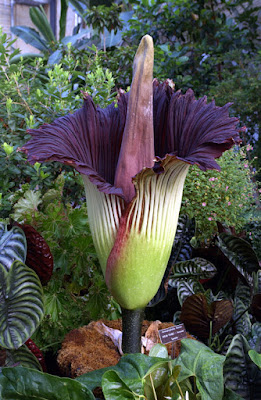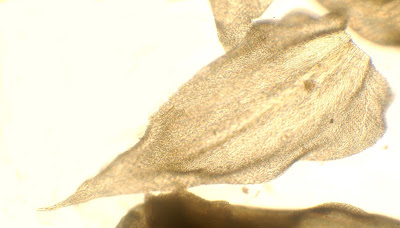 |
In the simple inflorescences of Indigo
(Indigofera spp., Fabaceae) new flowers
are produced at the tip for an extended
period of time, opening first at base, and
lasting only for a day or two. Many
inflorescences with more complex
branching patterns still open just a few
flowers at a time. |
An inflorescence can be defined as an aggregation of flowers on a specialized shoot that lacks ordinary leaves. The lack of full-sized, photosynthetic leaves is the key to defining an inflorescence, as opposed to a series of single flowers along a leafy branch. Within an inflorescence, leaves may in fact be present, but they are either smaller than normal, specialized in shape, conspicuously colored, or all of the above.
One common type of inflorescence, is one in which flowers open up one or a few at a time, for an extended period. Examples include lupines, snapdragons, gladioli, and foxgloves. Such inflorescences are adapted to induce "repeat visitors" - insects, birds, or other animals that remember the location of the plants and drop by each day to collect nectar or pollen from freshly opened flowers. This is a behavior known as trap lining.
In such flowers, a common means of avoiding self-pollination, is for the stamens and pistil within each flower to mature on different days. For example, pistils may be active and receptive to pollen on the day the flower opens, with the anthers opening to shed pollen 24 hours later. The common Amaryllis follows this pattern.
 |
| A common means of avoiding self-fertilization within individual flowers is to have pollen shed on one day (left) and stigmas receptive on another day (right). This effectively makes the flowers male on one day, and female on another day. |
Compound, or false flowers, such as those of the sunflower family or the spectacular poinsettias, are actually condensed inflorescences adapted to look like a single large flower to pollinators, but still opening their flowers a few at a time to attract trap-lining animals.
 |
In the compound flower heads of the Sunflower
Family, such as this Ice Daisy, the tiny flowers
(visible as the yellow rod-like structures)
around the outside of the central disk open first,
to be followed by flowers progressively closer
to the center. |
In other inflorescences, the flowers mature all at once to create a single, massive pollination event. I like to call these "superflowers." Super flowers don't necessarily look like a single flower, but they behave like one. In the most specialized of these kinds of inflorescences, flowers are unisexual, and the opening of the male and female flowers is offset, such that the entire inflorescence behaves as a single, short-lived flower. Examples of these are found most spectacularly in the Aroid and Palm Families.
 |
The Titan Arum, Amorphophallus titanum,
blooming at the U.S. Botanical Garden in
Washington, D.C., posted on Wikipedia. |
The Titan Arum, which makes the news whenever it blooms in a botanical garden, produces a gigantic inflorescence in which all the tiny flower buds are mature when the large bract, or spathe, opens to reveal them. They follow a similar strategy as the amaryllis flowers above, with separate female and male phases. In this case, all the female flowers are active first, followed by the male flowers in a day or two. This avoids self-pollination, as insects arrive during the female phase, bearing pollen from another inflorescence. They then leave during the male phase, freshly dusted with new pollen.
 |
Unlike the simple inflorescences
mentioned at the beginning of this post,
palm inflorescences complete most of
their development within their large,
protective bracts. No new branches or
flowers will form after the bracts open. In
many, such as this Rhopaloblaste, the
flowers will continue to expand for a
while, and may open over a prolonged
period of time in order to attract trap-
lining insects. |
The inflorescences of palms, despite being rather large, appear to be fairly simple assemblages of small flowers, yet some of them behave in much the same way as the Titan Arum. I made my discovery of these palm "superflowers" as a graduate student, first in Costa Rica, and later in New Guinea.
After waiting for a few hours at the edge of a swamp in Costa Rica, I found that inflorescences of a species of
Bactris opened abruptly at dusk, displaying unopened male flowers and active female flowers nestled within them. The inflorescence emitted a musky odor, which attracted a variety of small flies, bees, and beetles. The male flowers opened to release their pollen 24 hours later. I observed the same thing in another species of
Bactris later.
A year later, I was in Papua New Guinea and observed a nearly identical process in a species of
Hydriastele. I was able to get more detailed pictures of male and female flowers, along with their insect visitors, which I share below.
 |
Though it consists of a number of branches, the inflorescences
of Bactris guineensis behave the same as that of the Titan Arum. Female
flowers, hidden among the larger male flowers, are
receptive to pollen soon after the large, fibrous bract opens. |
 |
When the bract of a Hydriastele microspadix inflorescence splits
open, the flowers are all mature, and arranged in triads of
two large male flowers with a tiny female flower between them. |
 |
| When the flowers are first exposed, the stigmas of the tiny female flowers, seen at the left between pairs of male flowers, are exposed, sticky, and receptive to pollen.. The male flowers (right) only open 24 hours later to release their pollen. During the female phase, tiny flies and weevils are already present, attracted by the scent of the unopened male flowers. |
One further example from the palm family comes from the mangrove palm,
Nypa fruiticans, which lives in brackish water around river deltas and estuaries throughout the old world tropics. I spent a day observing them. Here the female flowers, which are rather bare and uninviting, are borne in a tight globose head at the top of the inflorescence. Male flowers are borne on dense orange-colored spikes below the female flowers. Brief observations suggested that pollination is accomplished by small flies that land first on the female flower heads, and then crawl down to the spikes of unopened male flowers where they lay their eggs. Larvae develop within the spikes, feeding on the unopened male flowers, and mature in a few days. When the new adult flies emerge, the male flowers have opened and are shedding pollen. The flies are then covered with the sticky pollen and fly off to start a new cycle on another
Nypa inflorescence.
 |
| Female flowers of Nypa form a dense globose head (left), and appear to provide no nutrition for insects. The dense male spikes (right), however, provide a place for fly larvae to develop as they feed on the tissues of the unopened male flowers. |















